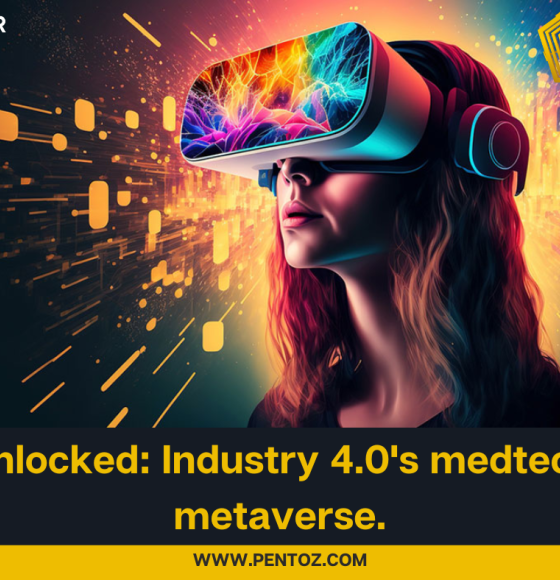Immersive mixed reality and extended reality technologies, which include augmented reality (AR) and virtual reality (VR) technologies, continue to be major forces behind company innovation and growth. This technical solution set has had a big impact on the industry landscape by changing how health manufacturing organizations operate, connect with their clients, and achieve their goals.
Realizing this trend, it is evident that businesses using AR/VR app development services to give their users immersive experiences will succeed both now and in the near future.
What are AR/VR?
Augmented reality (AR) and virtual reality (VR) are two distinct but related technologies that aim to enhance the user’s vision and interaction with the digital world. The equipment utilized and the type of experience are the primary differences between augmented reality and virtual reality: Unlike VR, which is purely virtual, augmented reality takes place in the actual world.
The immersive technology subset known as XR, or Extended Reality, includes both AR and VR. Mixed reality (MR), which effectively combines augmented reality (AR) and virtual reality (VR), is another option. It fuses the physical and digital realms to create a setting where they coexist and interact in real time.
Augmented reality, or AR, enhances a user’s perception of and interaction with their environment by superimposing digital data including photographs, videos, and 3D models onto the real world.
Users of AR technology can observe and interact with virtual items while still being aware of their local surroundings. A variety of industries, including manufacturing, construction, retail, healthcare, and more, have several uses for augmented reality.
When wearing a VR headset, users can interact with and move around in a virtual environment.
Even more intriguing is the fact that these immersive mixed reality technologies are combining with 3D artificial intelligence (AI), machine learning (ML), cloud services, and the Internet of Things (IoT) to power robotics and automation for businesses across industries, particularly in the expanding e-commerce environment. Companies in the manufacturing, healthcare, technology, building, energy, automotive, aerospace, and financial services industries, to name a few, are as a result more competitive and well-positioned for future growth.
By doing this, businesses can give their clients—whether they are partners in the supply chain or end users—a more robust and customized experience. Smart, shrewd, and prosperous businesses everywhere are transferring their workload infrastructures to cloud environments to introduce and oversee new tools for scalable operations.
Where immersive mixed reality continues to challenge enterprises
The difficulty is that new technologies need high data loads, the capacity to handle enormous volumes of data at lightning rates, and the capacity to scale projects in a computer environment, which is frequently not possible in typical office settings.
In order for businesses to benefit from “Industry 4.0” through the metaverse, there must be a precise and lasting integration of the physical and digital worlds. This entails producing intricate models and sceneries in photorealistic detail, at the proper geographic position (relative to both the actual and virtual worlds), with the appropriate size, and with an exact stance.
Consider the accuracy and precision needed to use AR/VR to design, construct, or repair parts of an airplane engine or a cutting-edge surgical tool for use in medical applications.
3D and AI are crucial for immersive mixed reality.
The ability to perfectly overlay a model or digital twin of an object on top of it is one of the prerequisites for mixed reality applications. This aids in supplying work instructions for assembly and training, as well as identifying any manufacturing faults or flaws. Additionally, as work advances, the user can keep track of the object(s) and modify the rendering.
The majority of on-device object tracking solutions use marker- or 2D image-based tracking. This indicates that even though consumers may appear to have a good match when viewing from a certain angle or position, the overlay loses alignment when the user moves around in 6DOF. This works effectively for symmetrical items, such as hands, faces, cups, tables, chairs, wheels, and regular geometrical structures, as well as smaller, simpler objects. However, tagged training data (especially in 3D) is not easily accessible for huge, complicated objects in enterprise use cases. This makes using the 2D image-based tracking to align, overlay, and persistently track the item and merge the rendered model with it in 3D challenging, if not impossible.
By incorporating 3D surroundings and AI technologies into their immersive mixed reality design and build projects, enterprise-level users are overcoming these difficulties.
Deep learning-based 3D AI enables users to recognize 3D objects in the 3D space with high accuracy, regardless of their size, shape, or orientation.
With this platform approach, users are able to overcome the limitations of the present device-only method and reach accuracy in millimeters in object registration and rendering. With the aid of life-size 3D rendering and overlay, users will be able to seamlessly blend the physical and digital worlds in enterprise applications. This will open up a wide range of applications, including but not limited to: training with precise contextual work instructions, defect and error detection in construction and assembly, and 3D design and engineering.
Why it’s essential to work in a cloud environment
It restricts the ability for businesses to exchange knowledge, which is important for developing new goods and figuring out the best strategy for virtual buildouts.
By utilizing cloud-based (or remote server-based) AR/VR systems supported by distributed cloud architecture and 3D vision-based AI, manufacturers are currently circumventing these restrictions. These cloud computing systems offer the performance and scalability needed to propel rapid and widespread industry innovation.

















